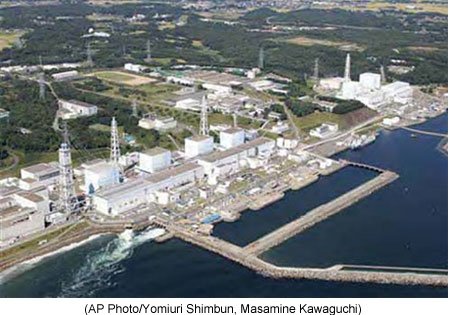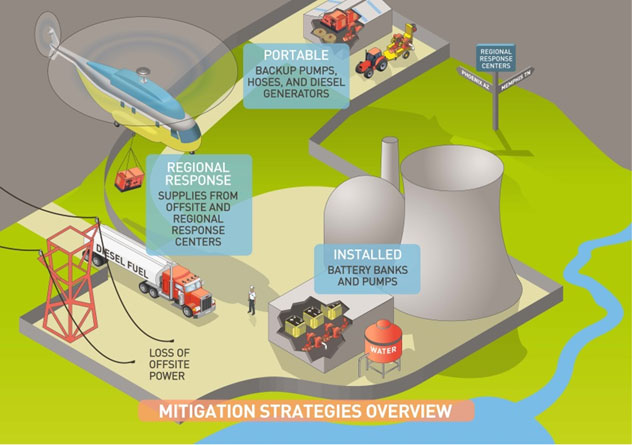Backgrounder on NRC Response to Lessons Learned from Fukushima
Printable Version
On this page:
Summary
In March 2012, the NRC ordered U.S. nuclear power plants to meet specific deadlines for: 1) maintaining key safety functions even if installed electricity sources fail; 2) installing additional equipment to monitor spent fuel pool water levels; and 3) installing/improving systems to safely vent pressure during an accident (for designs similar to Fukushima Dai-ichi). The NRC's March 2012 actions also asked all U.S. plants for information on comprehensive earthquake and flooding hazard analyses.

The Fukushima Dai-ichi Nuclear Accident
On March 11, 2011, a 9.0-magnitude earthquake struck Japan about 231 miles (372 kilometers) northeast of Tokyo off the Honshu Island coast. Eleven reactors at four sites (Fukushima Dai-ichi, Fukushima Dai-ni, Onagawa, and Tokai) along the northeast coast automatically shut down after the quake. Fukushima Dai-ichi lost all power from the electric grid, with diesel generators providing power for about 40 minutes. At that point, an estimated 45-foot-high (14 meter) tsunami hit the site, damaging many of the generators. Four of six Fukushima Dai-ichi reactors lost all power from the generators. The tsunami also damaged some of the site's battery backup systems.
 |
Units 1, 2 and 3 at Fukushima Dai-ichi were operating when the earthquake hit. Units 4, 5 and 6 were shut down for routine refueling and maintenance. One of Unit 6's diesel generators continued working, providing power to keep both Units 5 and 6 (at right in the photo) safely shut down. Steam-driven and battery-powered safety systems at Units 1, 2 and 3 worked for several hours (and more than a day in some cases). Those systems eventually failed and all three reactors overheated, melting their cores to some degree. The conditions in the reactors generated extreme pressure, causing leaks of radioactive gas as well as hydrogen. The hydrogen exploded inside the reactor buildings of Units 1, 3 and 4, damaging the buildings and releasing more radioactive material from Units 1 and 3. Radioactive contamination spread over a large area of Japan, requiring the relocation of tens of thousands of people. The Japanese government has reopened limited areas for residents to return to, but many communities remain off-limits. Japanese authorities eventually stabilized the damaged reactors with alternate water sources. Work continues to isolate the damaged reactors and radioactive contamination from the environment.

NRC’s Short-Term Actions
The NRC's 24-hour Operations Center in Rockville, Md., began monitoring the situation shortly after the earthquake and tsunami occurred. The NRC's first focus was potential tsunami effects on California's nuclear power plants and other nuclear materials users on the West Coast and in Hawaii, Alaska, and U.S. Pacific Territories. By the afternoon of March 11, the agency had fully staffed the Operations Center and begun interactions with Japanese regulators. The NRC sent two experts that weekend to assist the U.S. Embassy in Tokyo. By March 14, the agency had sent additional staff to provide technical support to the U.S. Embassy and the Japanese government. The NRC maintained its presence at the U.S. Embassy through December 2011.
On March 16, the NRC, along with other U. S. government agencies, provided technical information supporting the U.S. Embassy's advisory for American citizens to avoid the area within 50 miles of Fukushima Dai-ichi. The 50-mile recommendation expired in October 2011. The NRC also ensured U.S. nuclear power plants took action to prepare for a Fukushima-like event. The NRC told its inspectors to independently assess each plant's level of preparedness. The inspections covered procedures to compensate for extensive onsite damage, loss of all alternating current power, and seismic and flooding issues, as well as procedures for dealing with a damaged reactor.

NRC’s Long-Term Response
In April 2011, the Commission named a formal task force of senior NRC experts to examine information from the accident. The task force then reviewed NRC regulations to determine whether any actions were needed to ensure the safety of U.S. nuclear power plants. The task force's July 2011 report concluded U.S. reactors can continue operating safely while the NRC considers enhancements to existing safety and emergency preparedness requirements. The task force recommended a dozen broad enhancement areas for the Commission to consider. Later in 2011, the Commission approved staff proposals for prioritizing the specific actions suggested by the task force, as well as six additional topics related to the events at Fukushima.
The agency also created the Japan Lessons Learned Project Directorate, or JLD, to lead implementation of the task force recommendations. The overall progress in completing actions related to Fukushima recommendations has allowed the NRC to dissolve the JLD and move its activities into regular oversight of operating power reactors.
The agency issued three Orders in March 2012, requiring U.S. reactors to:
- Obtain and protect additional emergency equipment, such as pumps and generators, to support all reactors at a given site simultaneously following a natural disaster (pictured below).
- Install enhanced equipment for monitoring water levels in each plant's spent fuel pool.
- Improve/install emergency venting systems that can relieve pressure in the event of a serious accident (only for reactors with designs similar to the Fukushima plant).

Every U.S. commercial reactor has obtained the required additional onsite portable equipment and has satisfied the requirements of the emergency equipment Order. The U.S. nuclear industry has also established and stocked two offsite response centers. Every operating U.S. reactor has met the requirements for the spent fuel pool Order.
The NRC strengthened the venting Order in 2013, requiring the vents to handle the pressures, temperatures and radiation levels from a damaged reactor. The revised Order also calls for plants to ensure their personnel could operate the vents under those conditions. Twenty-eight of 30 reactors covered by the Order have met the requirements of the Order's first phase, and 15 of 30 have met the requirements of the second phase.
The NRC has also asked all U.S. reactors to re-confirm their flooding and earthquake preparedness, as well as re-analyze their earthquake and flooding hazards. All U.S. reactors have submitted their earthquake and flooding re-analyses. Based on those re-analyses, 49 reactor sites have completed limited additional earthquake evaluations. Five of 18 sites have completed more detailed seismic probabilistic risk analyses. Forty of 47 sites have completed limited flooding evaluations. Two of five sites has completed a more detailed integrated assessment of the flooding impacts on their site.
Other NRC activities include creating or revising rules related to maintaining key safety functions if a plant loses all alternating-current power, and several aspects of emergency preparedness. The NRC's website includes more information on Fukushima-related actions.
September 2018

Page Last Reviewed/Updated Tuesday, October 18, 2022